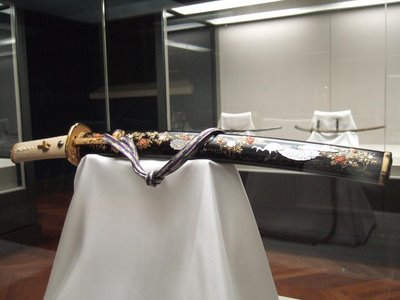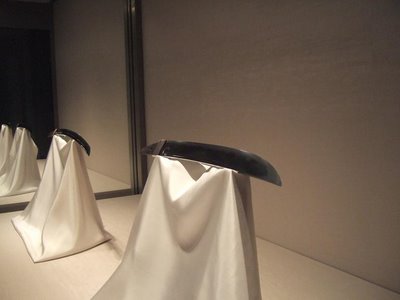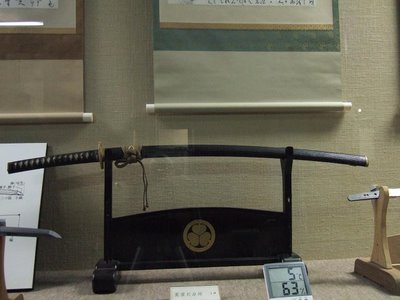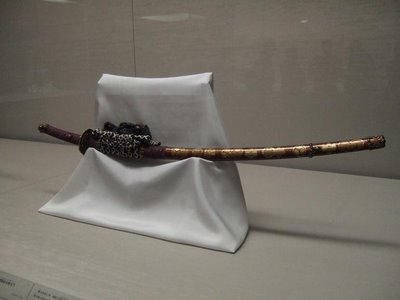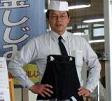Sunday, April 30, 2006
The kera
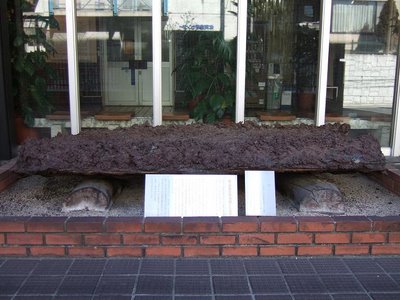
The Kera.
The Kera is crushed delicately. Carbon content chooses 0.3%-1.5 % of the steel from that. This is said as the tamahagane. The best material of the katana is the tamahagane. The tamahagane is hit with a hammer until it is thickness 3mm. That is broken in the smaller piece. They are sorted out the hard part from the soft part. Soft steel is used in the center of the katana. This is said as the shingane. Hard and beautiful steel is used for the surface. This is said as the kawagane.
Saturday, April 29, 2006
Tatara-fuki
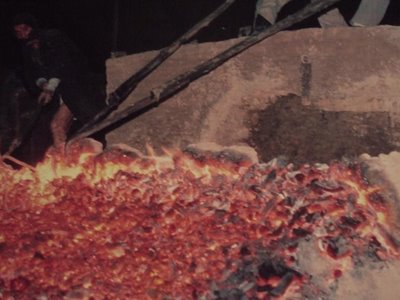
Steel is made by the steel manufacturing way of the Japanese tradition. This method is said as Tatarafuki. Iron sand and charcoal are used. The steel which purity is very high can be produced. That steel is reduced in the low temperature at 1300-1500 degrees. The mass of iron made by Tatarafuki is said as the Kera.
Friday, April 28, 2006
Hamon
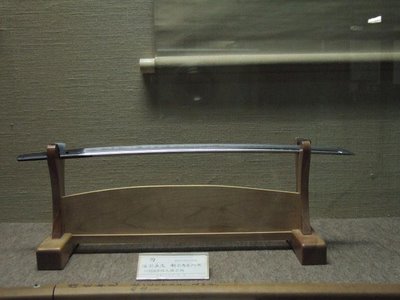
Hamon
See a Japanese sword well. There is a pattern which is peculiar to the part of the edge in the katana. This pattern is said as the Hamon. A straight line-like pattern is said as Suguha. The blade of the unique pattern is said as Midareba. This pattern is made at the time of quenching. The hamon doesn't influence the performance of the katana. It is important to quench a katana with water. But, it is not only performance that a katana is asked. Artistic beauty is looked for at the same time, too. The personality of the tosyo is shown there. That shows the characteristics of each school, too. But, when a war begins, a katana is returned to the strong weapon. A katana changes by the age.
Thursday, April 27, 2006
The Tosho
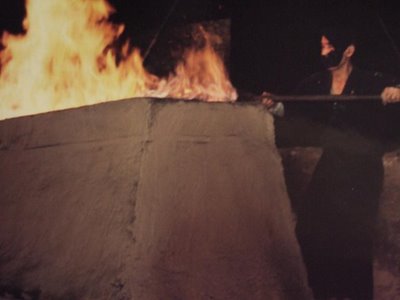
A katana has personality. A tosho begins to make that personality. Tosho is said as Katana-kaji. They are professionals. The skill was kept and succeeded by apprentice system. The skill has been succeeded to since the Warring States period. Possibly, it may be from the older age. Skill kept being succeeded to by a pupil from the teacher. Many tosho exist. Then, many katanas which famous tosho made exist. For example, they are Masamune, Muramasa, Osafune, Nagamitu, kunimitsu and yoshiyuki.
Wednesday, April 26, 2006
The gendaito
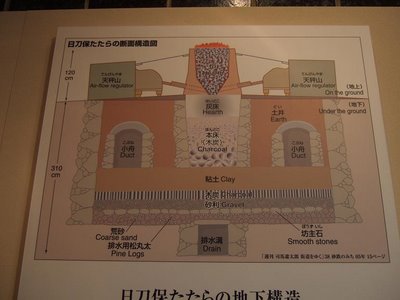
The gendaito.
The law was enforced in 1876 by Meiji new government . It was the law that having a katana was prohibited. But, a soldier, a policeman and an official were allowed to have a katana. Producers took a great influence by this law.
When a katana is made, a tamahagane ( steel ) is surely necessary. A tamahagane was made in the steel manufacturing method which was characteristic of Japan. The iron sand of good quality produced it in Chugoku district. Because of that, much good tamahagane was being made in Chugoku district. But, that had declined in the Meiji middle, too.
The tamahagane has been ever made in Shimane Prefecture Yokota-cho from 1933 to 1945. That was being called Yasukuni-Tatara. But, Japan was defeated in 1945 in World War II. A tamahagane production was stopped in the postwar confusion.
After that, The tamahagane which had already been made was used. But, it finished using that, too. That influenced the production of the katana. Farst of all, it was a big problem that the succession of the technology was interrupted, too. Yasukuni-Tatara was decided to be restored in 1977. This plan took the assistance of the country. But, there was only one person who knew the technology of the Yasukuni-Tatara. He accomplished this important duty though he was a great age. From then, it is called Nittoho-Tatara, and a tamahagane production and technician's training are being done.
At present, what is a katana being made for?
As a charm, As the goods of the dedication, As a trousseau, As a memorial gift, As a gift, As a family treasure, As a art. It disappeared that it was made as a weapon. The katana-kaji exists about 350 people at present.
Tuesday, April 25, 2006
The katana
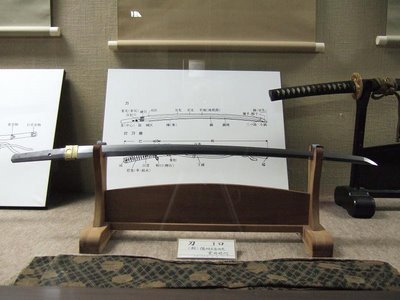
A koto, A shinto, A shinshinto, A gendaito
These are classification by the age of the katana. A katana before 1600 is said as Koto. The age of the war ended in 1600 due to the battle of Sekigahara. Demand for the katana changed after 1600. And, the way of entailing it and making it changed, too. Then, how to make it changed. A katana after 1600 is called Shinto. Masahide Suishinshi advocated restoration of the koto in 1764. A katana after 1764 is called Shinshinto. Then, a katana after the Meiji Restoration ( 1867 )is called Gendaito. Edo shogunate collapses, and a military family administration is finished due to the Meiji Restoration. Then, new government by the Emperor is organized. Various reforms were done. Japan advances to the modern nation. An artistic katana. A katana for the actual fighting. A katana was changing with the age.
Sunday, April 23, 2006
Wakizashi
Flower and birds in maki-e lacquer on ebony ground.
By Goto Ichijo.
Edo period, 19th century.
Emperor Komei had this wakizashi. Takayuki Todo who was Tsu clan master presented the Emperor with this wakizashi. Yoshihiro Soshyu made this blade. Nakano gave mother-of-pearl work. Ichijo Goto was a coordinator. The scabbard is drown a peacock and a peony flower in maki-e lacquer with mother-of-pearl work on ebony ground.
Saturday, April 22, 2006
The katana (Rai-Mitsukane)
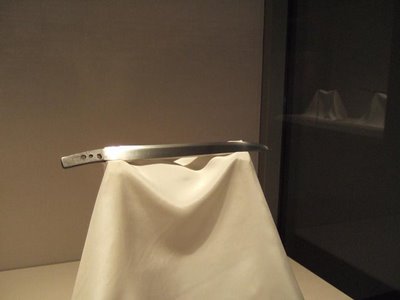
Rai-Mitsukane
Tanto SwordBy Mitsukane
Kamakura period, 13th century.
Mitsukane Rai is the pupil of Kunitoshi Rai in Kyoto. He lived in Ominokuni (Shiga Prefecture). It seems that he was making a sword by Enryakuji temple as well. This Tanto descended to the Matsudaira Family in Echizen (Fukui Prefecture).
Friday, April 21, 2006
Daisho
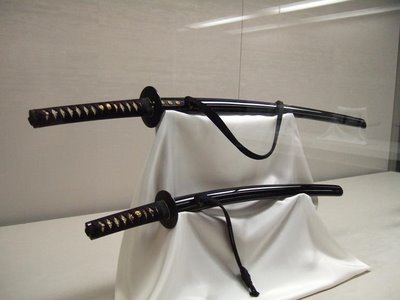
Daisho ( Pair of Long and Short Swords) Style.
Sword Mounting
With black-lacquer scabbard
Edo period, 19th century.
A katana became the main stream in the Momoyama Period and the Edo Period. A Daisho( Pair of Long and Short Swords) Style was used. A long katana is said as the Daito and a short katana is said as the Wakizashi or the Syoto.
A scabbard should be black painting and wind a handle with a black string and a tsuba (the guard of a sword ) should be brown. These were used as a formal kit.
Thursday, April 20, 2006
Wakizashi
Wakizashi Sword
By Kuninobu
Nanbokucho period, 14th century.
The Rai side, the Nobukuni side and the Hasebe side were the main streams in Kyoto in the Nanbokucho Period. It is said that Kunishige Hasebe and Kuninobu Hasebe are from Yamato (Nara Prefecture), too. Hasebe has the style which looks like Sosyu Hiromitsu. This wakizashi is his most important work.
By Kuninobu
Nanbokucho period, 14th century.
The Rai side, the Nobukuni side and the Hasebe side were the main streams in Kyoto in the Nanbokucho Period. It is said that Kunishige Hasebe and Kuninobu Hasebe are from Yamato (Nara Prefecture), too. Hasebe has the style which looks like Sosyu Hiromitsu. This wakizashi is his most important work.
Wednesday, April 19, 2006
Kodachi
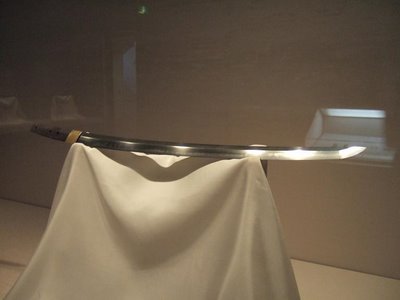
Kodachi Sword
By Kunimune
Kamakura period, 13th century.
A kodachi is a short tachi. It considers that a kodachi was hung like a tachi in the waist. A tachi is hung with the string in the waist. But, as for the use, it isn't clear. As for the length, it looks like a wakizashi. Kunimune was a katana-kaji in Bizen (Okayama Prefecture).
Tuesday, April 18, 2006
Odachi or Nodachi
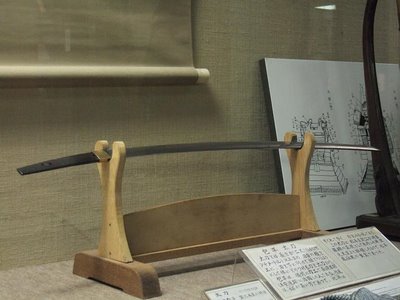
Kanehira tachi (Bizen Kanehira)
Heian period,12th century.
Odachi or NodachiThe katana of 90cm and more is called Odachi or Nodachi. The katana called Okanehira is famous. It seems that Odachi or Nodachi had already been made in the Heian Period latter term. It can't think that this long katana is carried every day. And, it is not the tachi which can be handled with one hand. But, the power may have been shown in the battlefield. A nodachi was made to use in the battlefield. It is favorable when a soldier fights against many enemies in the battlefield. Tokugawa shogunate prohibited a samurai's having a nodachi. A nodachi is favorable by the actual fighting.
Monday, April 17, 2006
A katana
The difference in a katana and a tachi.
There were many tachis before the 13th century ( About the Kamakura Period middle ) . There is a word of Uchigatana in literature of about the Kamakura Period middle. Therefore, a katana can be thought to be made in that age. A katana became general after sixteen centuries. A warrior has a tachi with one hand, and fights on the horse. A tachi was devised to handle it with one hand. A tachi is long because it fights on the horse. A katana was devised to handle it in both hands. Generally the length of a katana is about 60cm.
The reason why a katana became general. According to the change in the tactic, it can think about that. The Mongolian army attacked Japan in 1274. The tactics of the Japanese army at that time was bow and arrow and a piggyback fight. The Mongolian army was the collective right of attack to this. The Japanese army fought hard by this battle. The Japanese army had to change tactics. That is the collective right of attack by the infantryman.
There were many tachis before the 13th century ( About the Kamakura Period middle ) . There is a word of Uchigatana in literature of about the Kamakura Period middle. Therefore, a katana can be thought to be made in that age. A katana became general after sixteen centuries. A warrior has a tachi with one hand, and fights on the horse. A tachi was devised to handle it with one hand. A tachi is long because it fights on the horse. A katana was devised to handle it in both hands. Generally the length of a katana is about 60cm.
The reason why a katana became general. According to the change in the tactic, it can think about that. The Mongolian army attacked Japan in 1274. The tactics of the Japanese army at that time was bow and arrow and a piggyback fight. The Mongolian army was the collective right of attack to this. The Japanese army fought hard by this battle. The Japanese army had to change tactics. That is the collective right of attack by the infantryman.
Sunday, April 16, 2006
A tachi
The difference in a katana and a tachi.
When a Japanese sword is classified, there are a katana and a tachi. Generally both a katana and a tachi are attached to the left waist. At that time, a katana attaches an edge upward. A tachi attaches an edge downward. When it is attached, outside is the face of a sword. Then, the inside is a reverse side. A katana calls the face sashiomote. Then, the reverse side is called sashiura. A tachi calls the face hakiomote. Then, the reverse side is called hakiura. A katana is put between the obis. A tachi is hung with the string in the waist. It is said as 'Katana-wo-sasu' in Japanese that a katana is attached to the waist. It is said as 'Tachi-wo-haku' in Japanese that a tachi is attached to the waist.
When a Japanese sword is classified, there are a katana and a tachi. Generally both a katana and a tachi are attached to the left waist. At that time, a katana attaches an edge upward. A tachi attaches an edge downward. When it is attached, outside is the face of a sword. Then, the inside is a reverse side. A katana calls the face sashiomote. Then, the reverse side is called sashiura. A tachi calls the face hakiomote. Then, the reverse side is called hakiura. A katana is put between the obis. A tachi is hung with the string in the waist. It is said as 'Katana-wo-sasu' in Japanese that a katana is attached to the waist. It is said as 'Tachi-wo-haku' in Japanese that a tachi is attached to the waist.
Saturday, April 15, 2006
The katana (Hoki-Yasutsuna)
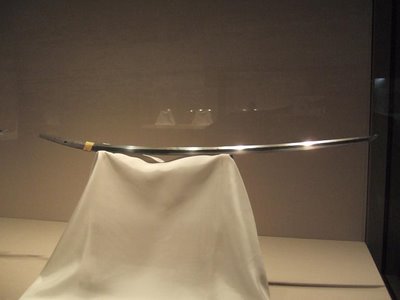
Tachi Sword
Known as " Dojigiri Yasutsuna "
By Yasutsuna
Heian Period 10th-11th century.
Hoki-Yasutsuna is an exponent of a katana-kaji in the Heian Period. The Dojigiri-Yasutsuna is the most famous in his work. About the origin of the name of the Dojigiri. There is a legend that Shuten-Doji who was a bandit was destroyed. It considers that this tachi was connected with this legend. This tachi was succeeded to with the Ashikaga general Family, the Tokugawa general Family, the Echizen Matsudaira Family and the Tsuyama Matsudaira Family. This tachi is the noted sword which represents Japan. This tachi is a national treasure.
Friday, April 14, 2006
The katana (Masamune)
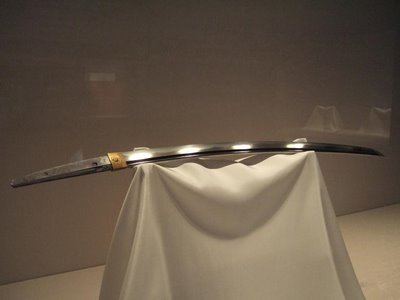
Katana Sword
Known as " Kanze Masamune "
By Masamune
Kamakura period , 14th century.
Kanze Masamune is the most important work of Masamune in Sagaminokuni (Kanagawa Prefecture). Masamune was the pupil of Kunimitsu Shintogo. Kunimitsu Shintogo's style was made to develop, and Masamune completed Sosyu style.
This katana is called Kanze Masamune. It is because that origin was descended to the Kanze Family. The Kanze Family is famous for the Noh play. The Kanze family presented the Ieyasu Tokugawa with the Kanze Masamune. Prince of the blood Arisugawanomiya-Taruhito was presented from the last general Yoshinobu-Tokugawa in the Meiji Period.
